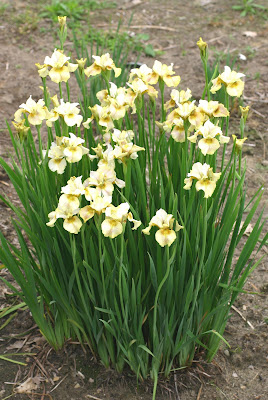In a previous blog we talked about doubling the chromosome
number in Siberians to produce tetraploids. Now I’d like to talk about another
kind of doubling - doubling the petal number. When we use “double” as a
description of a flower this is actually not very precise. Generally it would
mean more than usual number of petals and not a strict doubling of all the
flower parts. However, at least three different effects can cause this increase
in petal count in Siberians (I'm using "petals" here to include both petals (standards) and sepals (falls)). The resulting flowers look quite different
from each other. Probably you could see the same effects in other irises, but
we’re into Siberians here. The three routes to “doubling” are:
- The reproductive parts of the plant (stamens, stylearms,
ovary) are converted to petal--like structures (petalloids). Example 1 shows a
seedling where this is the predominant effect.
- Flowers are hose-in-hose where a second (or more)
flower grows up inside the first one. This can be seen in example 2 with a second complete flower growing up inside the first. Incidentally, this iris was
introduced recently as Double Play.
- The flower has six falls through the conversion of the
normal three standards into falls and with the sexual parts of flower unchanged.
Example 4 shows this effect (introduced as Six Love) but we won’t be talking about
it further here.
 |
| Example 1 |
|
|
|
 |
| Example 2 |
|
|
 |
| Example 3 |
 |
| Example 4 |
The
first two effects can be created by the same mutation – a master gene that
turns on the machinery to produce ovary, styles and stamens loses its activity
and the master gene controling petal formation in the same cell comes alive and takes
over, so we get lots of extra petal-like structures at the expense of the
reproductive parts. The same master gene is also responsible for making sure
that only one flower is produced from each terminal flower meristem. When it
loses its function this means that more than one meristem can produce flowers,
hence the hose-in-hose, multiple flower effect.
The 6- fall trait is caused by a different mutation that acts
specifically in controlling production of the standards (petals). These effects
can occur together complicating things further in terms of flower structure.
So
that’s the basics of how it happens, but why get excited about it? Well,
everyone likes variety and mutipetal flowers are very popular in many of the
major ornamental groups e.g. Japanese iris, peonies, dahlias, lilacs, roses,
petunias, and daffodils. More petals more flower power. Oh, by the way did you
spot that the photo in example 3 is a daffodil and not an iris? The control of
flower form is similar across most, if not all, flowering plants and the same
kinds of mutations occur so that we see these related multipetal effects
everywhere.
In
addition to the extra fullness, several special effects are possible with
multipetals including repeating expression of falls with strong blaze signals
as in Kaboom (Bauer-Coble, 2001: Example 5), or alternating layers of color
when you have a hose-in-hose structure in a bicolor or amoena
iris (color/white/color/white sequence) as shown with the seedlings in examples 6
(not fully open) and 7. These need further
development but the effects already make some novel and rather beautiful flowers.
 |
| Example 5 |
 |
| Example 6 |
 |
| Example 7 |
Mulipetal
(double) flowers have long been known but have not always been appreciated. The
famous French naturalist Rousseau said in his “Letters on the Elements of
Botany” (1787, 2nd Ed.) “Whenever
you find them double do not meddle with them, they are disfigured; or if you like,
dressed in our fashion: nature will no longer be found among them; she refuses
to reproduce anything from monsters thus mutilated, for if the more brilliant
parts of the flower, namely the corol, be multiplied, it is at the expense of
the more essential parts, which disappear under this addition of brilliancy”
Rousseau has hit on a real problem here. At least with the current multipetal
Siberians, it would be wonderful if every flower looked the same and was as
well organized as the ones in the photos, but sadly, that isn’t so. Every
flower on the plant may be different, and some can be less organized in form and quite untidy.
Why is this? The probable answer is that there are two copies of the genes for
each trait in diploid plants. In the case of multipetal Siberians only one of
these two genes is in the mutated state and the other is “normal”, so these two
control systems fight it out in each flower – sometimes the mutant form
predominates and the flower is almost fully doubled and seems symmetrical; in other cases the normal
gene tends to compete better (for unknown reasons) and the flower is less double and quite mixed up in
its structure. Only by finding a way to get both these genes in the mutated
(inactive) form can one put this battle to rest and expect to get fully double flowers
every time. And this is not so easy to do when the reproductive parts of the
flower, especially the ovaries, are heavily modified or not present! There is some pollen on the sides of the petalloids at times which is active and allows crosses to be made quite readily with standard Siberians, but, so
far, crosses with mutipetals as the pod parents have been unsuccessful – and these
plants never seem to produce bee pods either. So should we redouble our efforts to get
these potentially perfect (and perfectly sterile) multipetal forms or is it more
trouble than it’s worth?







































